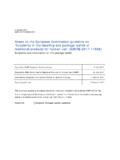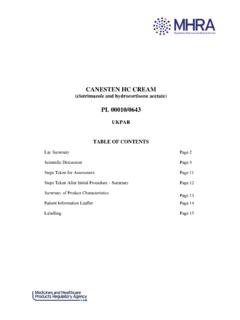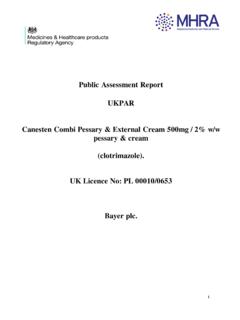Transcription of Questions and answers on wheat starch containing …
1 1 24 July 2014. 2 EMA/CHMP/704219/2013. 3 Committee for Human Medicinal Products (CHMP). 4 Questions and answers on wheat starch containing gluten 5 in the context of the revision of the guideline on 6 excipients in the label and package leaflet of medicinal 7 products for human use' (CPMP/463/00 Rev. 1). 8 Draft 9. Draft agreed by excipients Drafting group 21 July 2014. Adopted by CHMP for release for consultation 24 July 2014. Start of public consultation 1 August 2014. End of consultation (deadline for comments) 31 October 2014. 10. 11. Comments should be provided using this template. The completed comments form should be sent to 12. Keywords excipients , Package leaflet , Gluten, wheat starch 13.
2 30 Churchill Place Canary Wharf London E14 5EU United Kingdom Telephone +44 (0)20 3660 6000 Facsimile +44 (0)20 3660 5555. Send a question via our website An agency of the European Union European Medicines Agency, 2014. Reproduction is authorised provided the source is acknowledged. 14 Questions and answers on wheat starch containing gluten 15 as an excipient in the context of the revision of the 16 guideline on excipients in the label and package leaflet of 17 medicinal products for human use' (CPMP/463/00 ). 18 1. Background 19 Following the European Commission decision to revise the Annex of the guideline on excipients in the 20 label and package leaflet of medicinal products for human use' (CPMP/463/00 Rev.)
3 1) [1], a 21 multidisciplinary group of experts involving SWP (lead), QWP, PDCO, PRAC (ex PVWP), CMD(h), VWP, 22 BWP and BPWP was created in 2011. 23 The objective of this group is to update the labelling of selected excipients listed in the Annex of the 24 above mentioned EC guideline, as well as to add new excipients to the list, based on a review of their 25 safety. The main safety aspects to be addressed were summarised in a concept paper published in 26 March 2012 [2]. 27 Q&A documents on excipients will be progressively released for public consultation. They will include 28 proposals for new or updated information for the labelling and package leaflet . Once a Q&A is finalised, 29 the corresponding background report supporting its review will also be published.
4 30 When the Q&As of all the selected excipients have been finalised, they will be grouped in a single Q&A. 31 document. This information will be integrated in the updated Annex of the new revised EC guideline. 32 2. What is wheat starch ( containing gluten) and why is it 33 used as an excipient? 34 wheat starch is produced from wheat flour by removing proteins including gluten, meaning that wheat 35 starch only contains trace amounts of gluten and other proteins. 36 wheat starch is occasionally used as an excipient in the formulation of medicinal tablets, capsules and 37 ointments in a variety of functions; as a diluent, a disintegrant, a glidant, or as a binder. Dependent on 38 the quality of the wheat starch , gluten can be present; however there is currently no regulatory 39 guidance in place on the acceptable levels of gluten in medicinal products.
5 Gluten is covered only as a 40 constituent of wheat starch in the current guideline [1]. 41 Gluten is a protein composite found in wheat and related grain species such as rye and barley. 42 Gluten proteins can be divided into two main fractions according to their solubility in aqueous alcohols: 43 the soluble gliadins and the insoluble glutenins. Both fractions consist of numerous, closely related 44 protein components characterized by high glutamine and proline contents [3]. 45 In January 2009 a European Commission (EC) Regulation on gluten-free foods was adopted for foods 46 for special dietary use for persons intolerant to gluten. According to Commission Regulation (EC) No 47 41/2009, concerning the composition and labelling of foodstuffs suitable for people intolerant to gluten, 48 the following definitions are used to define levels of gluten in foodstuff.
6 Very low gluten' or gluten- 49 free' is used for indicating respectively a content of gluten not exceeding 100 mg/kg and 20 mg/kg 50 (100 ppm and 20 ppm respectively) [4]. Questions and answers on wheat starch containing gluten as an excipient in the context of the revision of the guideline on excipients in the label and package leaflet of medicinal products for human use' (CPMP/463/00 ). EMA/CHMP/704219/2013 Page 2/9. 51 3. Which medicinal products contain wheat starch ? 52 It is generally believed that only relatively few marketing authorisations are affected throughout the 53 EEA. For example, in the UK, a search of the MHRA database showed that there are 20 marketing 54 authorisations (MAs) that mention wheat starch as one of the excipients in the medicinal product.
7 Most 55 of these (n=19) are oral dosage forms and one is a topical preparation which is applied as an ointment 56 to the skin. Similarly in several other countries, relatively few MAs containing wheat starch were found, 57 mainly products for oral use. 58 The gluten content in MAs already approved should be determined as it is likely that protein levels are 59 confused with gluten levels. Many calculations provided assumed a gluten level of in PhEur 60 compliant wheat starch , however this is an incorrect assumption. The PhEur states that wheat starch 61 should contain no more than protein [5]. In literature it has been reported that at levels between 62 and protein, the gluten content varied between < to [6].
8 Following 63 communication with EDQM, it is assumed that a gluten content of no more than 100ppm is present in 64 wheat starch , when complying with the wheat starch monograph levels of protein. This is based 65 on notes provided by EDQM, when working on the wheat starch PhEur monograph. The notes provided 66 indicate that there is a correlation between total protein limit and gluten content, based on the Kjeldahl 67 paper [6], but also on additional tests conducted by experts at the time. 68 4. What are the safety concerns? 69 Coeliac sprue, also known as coeliac disease, is an autoimmune disorder of the digestive tract that 70 occurs in genetically pre-disposed people of all ages from infancy.
9 Coeliac disease is caused by a 71 reaction to gliadin, a prolamin (gluten protein) found in wheat , and similar proteins found in crops like 72 barley and rye. 73 It is a chronic disorder that results in an inability to tolerate gliadin. When patients with coeliac disease 74 ingest gliadin, an immunologically mediated inflammatory response occurs that damages the mucosa 75 of the intestines resulting in maldigestion and malabsorption [7-10]. 76 Coeliac disease occurs in adults and children and the rate of occurrence in the population is around 1%. 77 and prevalent all over the world [11-19]. In most affected people, coeliac disease remains 78 undiagnosed [20] although the rate of diagnosis is increasing [21].
10 79 The only known effective treatment is a lifelong gluten-free diet. When a patient with coeliac disease is 80 exposed to gluten, the patient may develop symptoms that include pain and discomfort in the digestive 81 tract, chronic constipation and diarrhoea, failure to thrive (in children), anaemia, weight loss, 82 weakness and fatigue, but these may be absent, and symptoms in other organ systems can develop. 83 The extraintestinal symptoms include osteopenia, osteoporosis, skin disorders, neurological and 84 hormonal disorders [8-10]. 85 Upon exposure to gliadin, and specifically to three peptides found in prolamin, the enzyme tissue 86 transglutaminase modifies the protein, and the immune system cross-reacts with the small-bowel 87 tissue, causing an inflammatory reaction.













